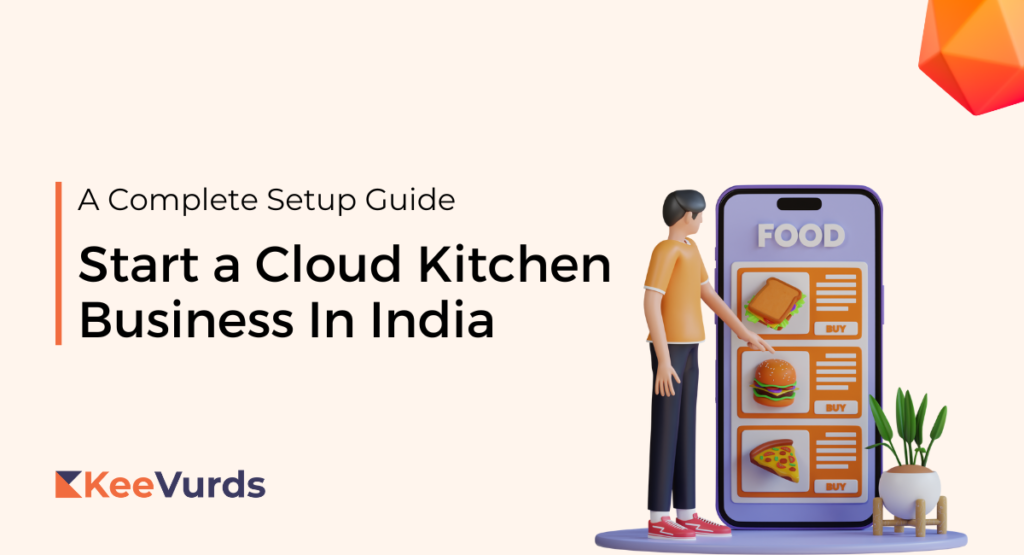The restaurant industry in India has been hit hard by the ongoing COVID-19 pandemic, and many traditional restaurant owners are struggling to stay afloat.
In these trying times, a concept that has been gaining immense popularity is that of cloud kitchens.
A cloud kitchen, also known as a ghost kitchen or virtual kitchen, is essentially a restaurant kitchen that operates solely for delivery, with no dine-in option. This innovative concept is not only cost-effective but also offers greater flexibility and scalability for restaurant owners.
According to recent statistics, the global cloud kitchen market size is projected to reach USD 71.4 billion by 2027, with a CAGR of 12.0% from 2021 to 2027. In India, the cloud kitchen market is expected to grow at a CAGR of 25% from 2020 to 2025, driven by the increasing demand for online food delivery services.
Whether you are a traditional restaurant owner looking to pivot to a cloud kitchen model or a new entrepreneur looking to start a food delivery business, this article will provide you with all the information you need to get started.
Why Cloud Kitchens are the Future of the Restaurant Industry
The number of cloud kitchens has been growing at a rate of 20% every year, with more than 20,000 cloud kitchens operating in Delhi itself.
Cloud kitchen startups are also growing rapidly, backed by VCs. In 2020, cloud kitchen startups received a total funding of $112.4 million. The numbers doubled in 2021 with total funding of $234.2 million.
Indian youth population and disposable income is growing, creating a huge scaling opportunity for cloud kitchens. Unlike countries like China and the US, the Indian cloud kitchen industry is not penetrated much. The market share is bound to increase, and there’s significant room for growth.
A Complete Guide to Open a Cloud Kitchen In India
With the right strategy, a cloud kitchen can turn into a big business. However, you need the right resources, budget, and marketing to start bringing in profits.
Let’s discuss the main pointers like location, licensing, and other essential factors to start a cloud kitchen in India.
Finding the Right Location for Your Cloud Kitchen
Finding the right location is the first step and a major one to opening your cloud kitchen. First, you must find a place where you can expect a huge demand for the type of food your kitchen is going to deliver.
For that, you must analyze the demographics of the location to understand their food habits. For instance, many locations in India might prefer only vegetarian food and would not even buy veg from a place that also serves non-veg.
Another thing to keep in mind is that the rental place must have a constant water supply, sanitation, and maintenance. Try to find a place with minimum rent that contains all these facilities in the right location.
Naming and Legal Procedures
The next step in setting up your cloud kitchen is to finalize a name and get a commercial license. You can pick a name that resonates with the type of food you’re going to offer. You can also choose a name based on location if you serve dishes specific to that location, such as South Indian, Hyderabadi, or Bengali dishes.
Licenses are necessary for legal regulations. They build trust among your customers that you’re a proper legal entity providing the best quality food. You don’t need as many licenses as a traditional restaurant. But here are the primary ones you need –
- Food Safety and Standards Authority of India (FSSAI) license
- GST Registration
- Trade License
- Fire & Safety
Licensing ensures that the owner of the cloud kitchen will stay out of legal trouble by following all regulations.
Setting Up Your Cloud Kitchen Infrastructure
Depending on what you serve, you must have the proper kitchen infrastructure. For example, you can’t do without an oven if you offer pizza. Kitchen equipment and utensils will take up a major portion of your total investment.
Hence, you can decide to buy the important items (stoves, freezers, microwaves, fridges, fryers, etc.) that are brand new. In comparison, you can purchase some less important things (tables, storing shelves, chairs, etc.) second-hand.
Creating an Effective Menu for Your Cloud Kitchen
Your food menu can make or break your cloud kitchen business. Cloud kitchens don’t operate like traditional restaurants. You rely solely on online orders, and your menu must stand out from the rest to entice customers.
With that in mind, you can initially focus on a specific type of cuisine. Choosing this particular cuisine can be a big challenge. However, you can consider the availability of raw materials, existing resources, demand, and staff management to make this decision.
Hiring and Training Staff for Your Cloud Kitchen
You cannot compromise quality if you run a cloud kitchen in India. Therefore, you must put a lot of thought into staffing. Initially, you don’t need more than 1-2 chefs, 1-2 people to manage billings, and 1 marketer.
The chefs must be well-trained. If your cloud kitchen offers Chinese food, the chef must be well-trained in cooking different types of Chinese cuisine.
Managing Inventory and Supplies in Your Cloud Kitchen
It is crucial to choose the right vendors from the beginning. They must be able to deliver the raw materials as per the daily demand. Order the frozen items in advance that you can store in a freezer for days. Do not wait for the supplies to run out.
Invest in the packaging too. Ensure packaging is sturdy enough, so there’s no spillage issue. Use some branding elements to create a brand recall.
Adding Your Business to Zomato, Swiggy, and More – H3
It is challenging to run a successful cloud kitchen in India without listing it on online aggregators, such as Zomato and Swiggy. Both Zomato and Swiggy operate in more than 500 cities in India. Swiggy has 20 million, while Zomato has 32 million active users.
You cannot overlook the reach both of them can provide you in the starting. You can create a listing with them easily by visiting the websites of Swiggy and Zomato. Create an account and submit the required documents, such as the FSSAI certificate, menu, and PAN card.
Marketing Your Cloud Kitchen Business
Marketing plays a pivotal role in your cloud kitchen’s success. It doesn’t stop after adding your business to Swiggy and Zomato. You must take advantage of all the marketing channels available. These include –
- Local Listings – You can create a Google My Business profile to include your business in Google’s local listings. To increase visibility, you can also create listings on sites like Yelp and other relevant business directories.
- SMS and Email Marketing – You can introduce offers and discounts to your potential customers through SMS and emails. Try to customize your messages and emails for a better customer experience.
- Social Media – You cannot survive without social media presence today. Social media platforms are ideal for creating brand awareness and engaging with your target audience. With a solid vocal and visual brand on social media, you can attract customers and scale your cloud kitchen business.
Managing Orders and Deliveries in Your Cloud Kitchen
It is important to keep track of the number of orders you receive. Sometimes, you might receive orders from different aggregators or your own website. You have to ensure that the food is prepared and delivered on time.
It is hard to track orders from different aggregators and write them down manually.
Therefore, you can opt for a POS or online order management system to keep track of all your food orders and access all the data on one dashboard. This will streamline the process of getting order-related information from different channels and tracking them effectively.
How Much Does it Cost to Start a Cloud Kitchen?
Starting a cloud kitchen can be cost-effective, but you may still need INR 4.5 lakh to INR 11 lakh to start a cloud kitchen.
- Rental space may cost anywhere from INR 20,000 to INR 50,000 per month for an area of 300-600 sq ft with a deposit of INR 1,00,000-2,00,000 in metro cities like Bengaluru and Mumbai
- Licenses may cost from as low as INR 3,000 to INR 20,000
- Kitchen equipment can cost anywhere from INR 2,00,000 to INR 6,00,000, depending on your requirements and your options
- Staff can cost you INR 45,000 to INR 90,000
- Digital marketing (including paid and organic marketing) can easily cost INR 30,000 to INR 80,000
- Order management software can cost INR 4,000-6,000 yearly
- Branding and packaging can also cost around INR 40,000 to INR 60,000
Pros and Cons of a Cloud Kitchen Business Model
Just like every business model, a cloud kitchen has its pros and cons.
Pros:
- Does not require a large capital
- Overhead and labour costs are low
- Easier to expand without additional overhead costs
- Gross margin is high due to low overhead and labour costs
Cons:
- Competition is high as you’re competing against other cloud kitchens and restaurants on aggregators
- Trust deficit as there’s no frontage to build local awareness
- No interaction with customers to create a great in-person customer service experience
Conclusion
Since Covid, cloud kitchen has been one of the most popular businesses in India. The pandemic has changed people’s eating habits, with more people ordering online than ever.
As the requirements are few and the pros outweigh the cons, a cloud kitchen can be a good business idea. With a small infrastructure, staff, and space, you can efficiently run and scale your cloud kitchen startup.





1 Comment